An abnormal amount of lipids in blood is called dyslipidemia, which includes abnormal levels of cholesterol, triglycerides, and/or lipoproteins. Dyslipidemia may be primary (familial) or secondary (acquired). Both primary and secondary causes can lead to the development of premature atherosclerotic cardiovascular disease (ASCVD). Familial causes are classified according to the Fredrickson system, which looks into the pathology and the lipids that are elevated. Certain types do not increase the risk of premature atherosclerotic disease but still impact overall cardiac risk and chance of cardiovascular events in the future. Screening, early diagnosis, and strict control and management are the keys to prevention of cardiovascular events.
Last updated: Sep 12, 2025
Dyslipidemia: abnormal amounts of lipids Lipids Lipids are a diverse group of hydrophobic organic molecules, which include fats, oils, sterols, and waxes. Fatty Acids and Lipids in the blood
Lipid disorders Lipid disorders An abnormal amount of lipid in blood is called dyslipidemia, which includes abnormal levels of cholesterol, triglycerides, and/or lipoproteins. Dyslipidemia may be primary (familial) or secondary (acquired). Both primary and secondary causes can lead to the development of premature cardiovascular (atherosclerosis) disease. Lipid Disorders are due to a combination of diet and lifestyle habits coupled with a genetic predisposition.
Causes of dyslipidemia can be divided into primary (familial) and secondary (acquired) causes.
Primary causes:
Secondary (acquired) causes:
| Type | Condition, mode of inheritance ( AD AD The term advance directive (AD) refers to treatment preferences and/or the designation of a surrogate decision-maker in the event that a person becomes unable to make medical decisions on their own behalf. Advance directives represent the ethical principle of autonomy and may take the form of a living will, health care proxy, durable power of attorney for health care, and/or a physician’s order for life-sustaining treatment. Advance Directives, AR AR Aortic regurgitation (AR) is a cardiac condition characterized by the backflow of blood from the aorta to the left ventricle during diastole. Aortic regurgitation is associated with an abnormal aortic valve and/or aortic root stemming from multiple causes, commonly rheumatic heart disease as well as congenital and degenerative valvular disorders. Aortic Regurgitation), lipid abnormality | Pathology | Notes |
|---|---|---|---|
| I |
Familial hyperchylomicronemia
Familial Hyperchylomicronemia
Lipid Disorders (
AR
AR
Aortic regurgitation (AR) is a cardiac condition characterized by the backflow of blood from the aorta to the left ventricle during diastole. Aortic regurgitation is associated with an abnormal aortic valve and/or aortic root stemming from multiple causes, commonly rheumatic heart disease as well as congenital and degenerative valvular disorders.
Aortic Regurgitation) Elevated chylomicrons |
Deficiency in LPL or ApoC-II |
|
| IIa |
Familial hypercholesterolemia
Familial hypercholesterolemia
Lipid Disorders(FH) (
AD
AD
The term advance directive (AD) refers to treatment preferences and/or the designation of a surrogate decision-maker in the event that a person becomes unable to make medical decisions on their own behalf. Advance directives represent the ethical principle of autonomy and may take the form of a living will, health care proxy, durable power of attorney for health care, and/or a physician’s order for life-sustaining treatment.
Advance Directives) Elevated LDL |
Mutation Mutation Genetic mutations are errors in DNA that can cause protein misfolding and dysfunction. There are various types of mutations, including chromosomal, point, frameshift, and expansion mutations. Types of Mutations in PCSK-9, defective LDL receptors Receptors Receptors are proteins located either on the surface of or within a cell that can bind to signaling molecules known as ligands (e.g., hormones) and cause some type of response within the cell. Receptors or ApoB-100 |
|
| IIb |
Familial combined hypercholesterolemia
Familial Combined hypercholesterolemia
Lipid Disorders (
AD
AD
The term advance directive (AD) refers to treatment preferences and/or the designation of a surrogate decision-maker in the event that a person becomes unable to make medical decisions on their own behalf. Advance directives represent the ethical principle of autonomy and may take the form of a living will, health care proxy, durable power of attorney for health care, and/or a physician’s order for life-sustaining treatment.
Advance Directives) Elevated VLDL and LDL |
|
|
| III |
Familial hyperlipoproteinemia
Familial hyperlipoproteinemia
Lipid Disorders (
AR
AR
Aortic regurgitation (AR) is a cardiac condition characterized by the backflow of blood from the aorta to the left ventricle during diastole. Aortic regurgitation is associated with an abnormal aortic valve and/or aortic root stemming from multiple causes, commonly rheumatic heart disease as well as congenital and degenerative valvular disorders.
Aortic Regurgitation) Remnants of VLDL and chylomicrons |
Defective ApoE |
|
| IV |
Familial hypertriglyceridemia
Familial hypertriglyceridemia
Lipid Disorders (
AD
AD
The term advance directive (AD) refers to treatment preferences and/or the designation of a surrogate decision-maker in the event that a person becomes unable to make medical decisions on their own behalf. Advance directives represent the ethical principle of autonomy and may take the form of a living will, health care proxy, durable power of attorney for health care, and/or a physician’s order for life-sustaining treatment.
Advance Directives) Elevated VLDL |
Excessive VLDL production by the liver Liver The liver is the largest gland in the human body. The liver is found in the superior right quadrant of the abdomen and weighs approximately 1.5 kilograms. Its main functions are detoxification, metabolism, nutrient storage (e.g., iron and vitamins), synthesis of coagulation factors, formation of bile, filtration, and storage of blood. Liver: Anatomy |
|
| V |
Mixed hyperlipidemia
Mixed Hyperlipidemia
Lipid Disorders (
AR
AR
Aortic regurgitation (AR) is a cardiac condition characterized by the backflow of blood from the aorta to the left ventricle during diastole. Aortic regurgitation is associated with an abnormal aortic valve and/or aortic root stemming from multiple causes, commonly rheumatic heart disease as well as congenital and degenerative valvular disorders.
Aortic Regurgitation) Elevated chylomicrons and VLDL |
Defective ApoA5 |
|
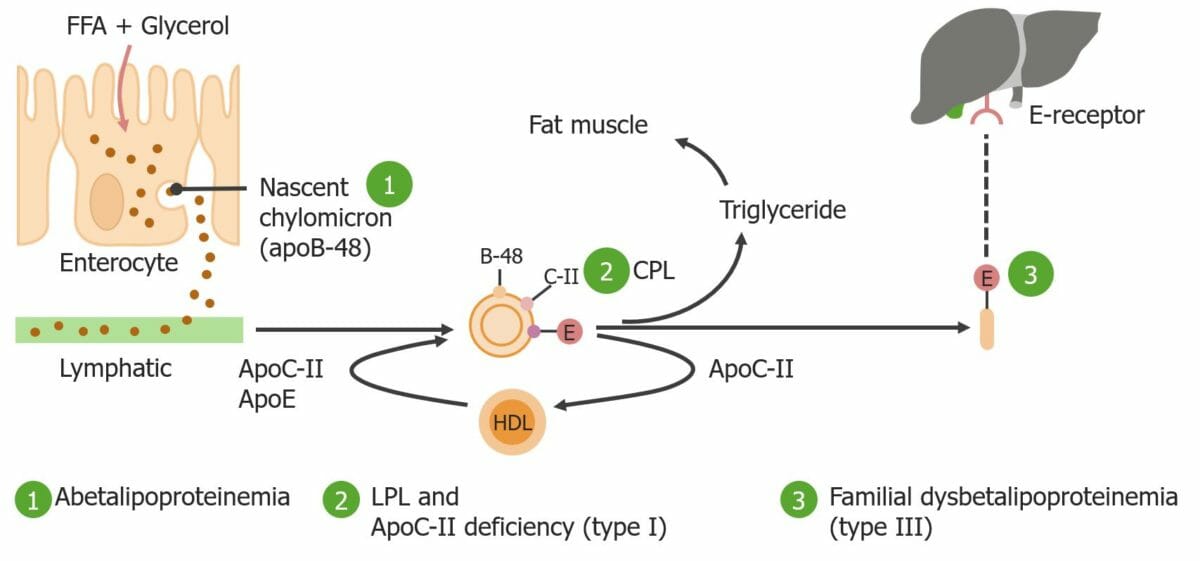
Schematic depiction of the Fredrickson classification types I and III
FFA: free fatty acid
ApoB-48: apolipoprotein-B-48
ApoC-II: apolipoprotein C-II
ApoE: apolipoprotein E
LPL: lipoprotein lipase
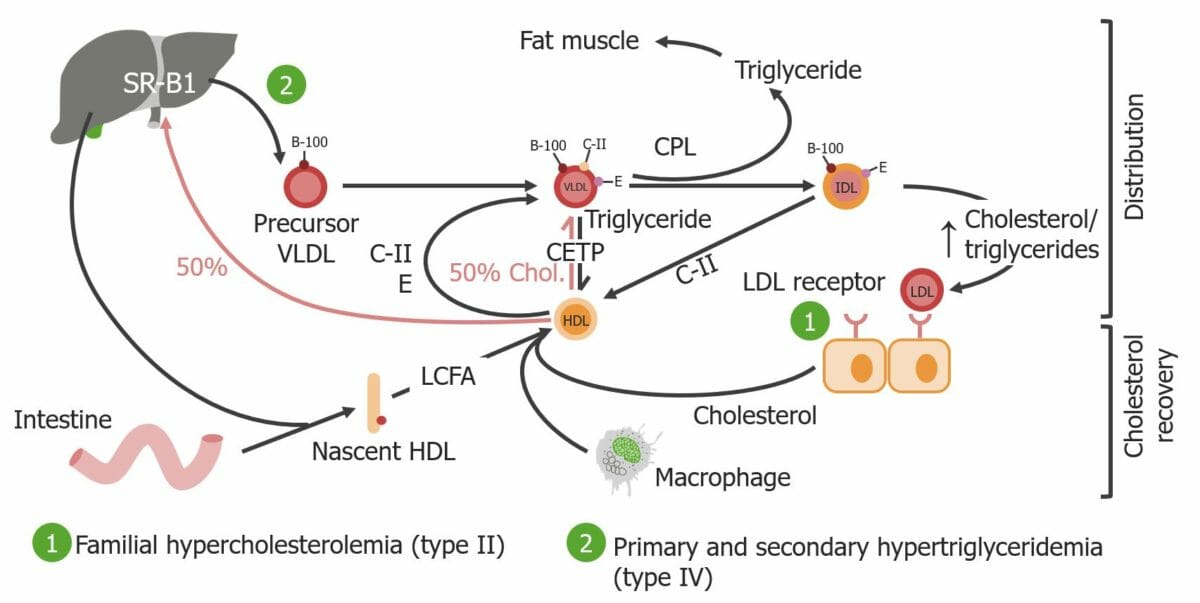
Schematic depiction of Fredrickson classification types II and IV
Image by Lecturio.Many individuals with hyperlipidemia and hypertriglyceridemia Hypertriglyceridemia A condition of elevated levels of triglycerides in the blood. Lipid Disorders are asymptomatic, without symptoms and signs (other than those listed below). The most common clinical manifestation of lipid disorders Lipid disorders An abnormal amount of lipid in blood is called dyslipidemia, which includes abnormal levels of cholesterol, triglycerides, and/or lipoproteins. Dyslipidemia may be primary (familial) or secondary (acquired). Both primary and secondary causes can lead to the development of premature cardiovascular (atherosclerosis) disease. Lipid Disorders is ASCVD.[17,23]
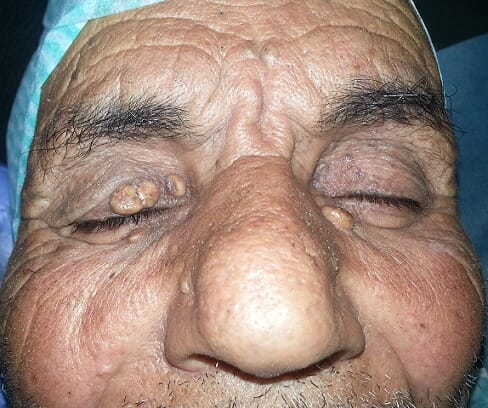
An elderly patient with yellow-tan deposits around the eyelids, most likely indicative of xanthelasma
Image: “Les différentes lésions jaunâtres au niveau des deux paupières en rapport avec le xanthélasma” by Elghazi, T. and Hafidi, Z. License: CC BY 2.0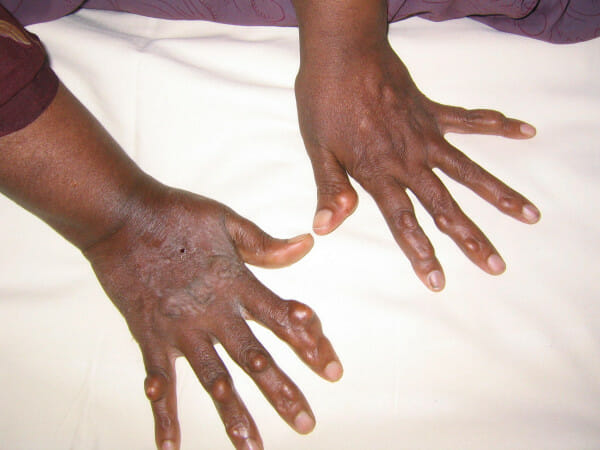
Multiple xanthomas on hands
Image: “Xanthomas” by Kumar, A.A. et al. License: CC BY 2.0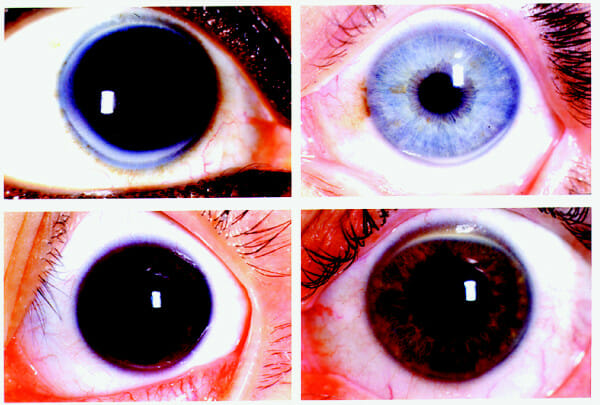
Four representative slides of corneal arcus:
Arcus deposits tend to start at 6 and 12 o’clock and fill in until becoming completely circumferential.
Dyslipidemia is defined as lipid values associated with an increased risk of and/or presence of disease for which the initiation of lipid-lowering therapy will be of benefit. There is controversy regarding the age at which to start screening Screening Preoperative Care, and guidelines for children and young adults vary. The recommendations listed below are based on the American Heart Association American Heart Association A voluntary organization concerned with the prevention and treatment of heart and vascular diseases. Heart Failure guidelines.
| Lipid | Desirable value |
|---|---|
| Total cholesterol Cholesterol The principal sterol of all higher animals, distributed in body tissues, especially the brain and spinal cord, and in animal fats and oils. Cholesterol Metabolism |
|
| HDL cholesterol Cholesterol The principal sterol of all higher animals, distributed in body tissues, especially the brain and spinal cord, and in animal fats and oils. Cholesterol Metabolism |
|
| LDL cholesterol Cholesterol The principal sterol of all higher animals, distributed in body tissues, especially the brain and spinal cord, and in animal fats and oils. Cholesterol Metabolism |
|
| TGs |
|
The aim of management is to reduce the risk of cardiovascular disease including heart attack Heart attack Mi is ischemia and death of an area of myocardial tissue due to insufficient blood flow and oxygenation, usually from thrombus formation on a ruptured atherosclerotic plaque in the epicardial arteries. Clinical presentation is most commonly with chest pain, but women and patients with diabetes may have atypical symptoms. Myocardial Infarction and stroke.[8]
| Therapy intensity | Typical medication choice and dose (adult) |
|---|---|
| High intensity |
|
| Moderate intensity |
|
| Low intensity |
|
Diagnosis Codes:
These codes are used to diagnose various types of dyslipidemia, or abnormal amounts of
lipids
Lipids
Lipids are a diverse group of hydrophobic organic molecules, which include fats, oils, sterols, and waxes.
Fatty Acids and Lipids in the blood. The codes specify the type of lipid that is elevated, such as pure
hypercholesterolemia
Hypercholesterolemia
A condition with abnormally high levels of cholesterol in the blood. It is defined as a cholesterol value exceeding the 95th percentile for the population.
Lipid Disorders (high
cholesterol
Cholesterol
The principal sterol of all higher animals, distributed in body tissues, especially the brain and spinal cord, and in animal fats and oils.
Cholesterol Metabolism),
hypertriglyceridemia
Hypertriglyceridemia
A condition of elevated levels of triglycerides in the blood.
Lipid Disorders (high
triglycerides
Triglycerides
Fatty Acids and Lipids), or
mixed hyperlipidemia
Mixed Hyperlipidemia
Lipid Disorders (both are high).
| Coding System | Code | Description |
|---|---|---|
| ICD-10-CM | E78.00 | Pure hypercholesterolemia Hypercholesterolemia A condition with abnormally high levels of cholesterol in the blood. It is defined as a cholesterol value exceeding the 95th percentile for the population. Lipid Disorders, unspecified |
| ICD-10-CM | E78.2 | Mixed hyperlipidemia Mixed Hyperlipidemia Lipid Disorders |
| ICD-10-CM | E78.1 | Pure hyperglyceridemia |
| SNOMED CT | 55822004 | Hyperlipidemia (disorder) |
Evaluation & Workup:
This CPT code is for a standard fasting lipid panel, the essential blood test to diagnose and monitor
lipid disorders
Lipid disorders
An abnormal amount of lipid in blood is called dyslipidemia, which includes abnormal levels of cholesterol, triglycerides, and/or lipoproteins. Dyslipidemia may be primary (familial) or secondary (acquired). Both primary and secondary causes can lead to the development of premature cardiovascular (atherosclerosis) disease.
Lipid Disorders. It measures total
cholesterol
Cholesterol
The principal sterol of all higher animals, distributed in body tissues, especially the brain and spinal cord, and in animal fats and oils.
Cholesterol Metabolism,
high-density lipoprotein
High-density lipoprotein
A class of lipoproteins of small size (4-13 nm) and dense (greater than 1. 063 g/ml) particles. HDL lipoproteins, synthesized in the liver without a lipid core, accumulate cholesterol esters from peripheral tissues and transport them to the liver for re-utilization or elimination from the body (the reverse cholesterol transport). Their major protein component is apolipoprotein A-I. HDL also shuttle apolipoproteins C and apolipoproteins E to and from triglyceride-rich lipoproteins during their catabolism. Hdl plasma level has been inversely correlated with the risk of cardiovascular diseases.
Cholesterol Metabolism (HDL)
cholesterol
Cholesterol
The principal sterol of all higher animals, distributed in body tissues, especially the brain and spinal cord, and in animal fats and oils.
Cholesterol Metabolism,
low-density lipoprotein
Low-density lipoprotein
A class of lipoproteins of small size (18-25 nm) and light (1. 019-1. 063 g/ml) particles with a core composed mainly of cholesterol esters and smaller amounts of triglycerides. The surface monolayer consists mostly of phospholipids, a single copy of apolipoprotein B-100, and free cholesterol molecules. The main ldl function is to transport cholesterol and cholesterol esters to extrahepatic tissues.
Cholesterol Metabolism (LDL)
cholesterol
Cholesterol
The principal sterol of all higher animals, distributed in body tissues, especially the brain and spinal cord, and in animal fats and oils.
Cholesterol Metabolism, and
triglycerides
Triglycerides
Fatty Acids and Lipids.
| Coding System | Code | Description |
|---|---|---|
| CPT | 80061 | Lipid panel |
Medications:
These codes are for the primary classes of medications used to treat
lipid disorders
Lipid disorders
An abnormal amount of lipid in blood is called dyslipidemia, which includes abnormal levels of cholesterol, triglycerides, and/or lipoproteins. Dyslipidemia may be primary (familial) or secondary (acquired). Both primary and secondary causes can lead to the development of premature cardiovascular (atherosclerosis) disease.
Lipid Disorders.
Statins
Statins
Statins are competitive inhibitors of HMG-CoA reductase in the liver. HMG-CoA reductase is the rate-limiting step in cholesterol synthesis. Inhibition results in lowered intrahepatocytic cholesterol formation, resulting in up-regulation of LDL receptors and, ultimately, lowering levels of serum LDL and triglycerides.
Statins are the first-line therapy for high LDL
cholesterol
Cholesterol
The principal sterol of all higher animals, distributed in body tissues, especially the brain and spinal cord, and in animal fats and oils.
Cholesterol Metabolism, while
fibrates
Fibrates
Lipid Control Drugs are often used for very high
triglycerides
Triglycerides
Fatty Acids and Lipids.
| Coding System | Code | Description |
|---|---|---|
| RxNorm | 83367 | Atorvastatin Atorvastatin A pyrrole and heptanoic acid derivative, hydroxymethylglutaryl-CoA reductase inhibitor (statin), and anticholesteremic agent that is used to reduce serum levels of ldl-cholesterol; apolipoprotein b; and triglycerides. It is used to increase serum levels of hdl-cholesterol in the treatment of hyperlipidemias, and for the prevention of cardiovascular diseases in patients with multiple risk factors. Statins (ingredient) |
| RxNorm | 401734 | Ezetimibe Ezetimibe An azetidine derivative and anticholesteremic agent that inhibits intestinal sterol absorption. It is used to reduce total cholesterol; ldl cholesterol, and apolipoproteins B in the treatment of hyperlipidemias. Lipid Control Drugs (ingredient) |
| RxNorm | 4337 | Fenofibrate Fenofibrate An antilipemic agent which reduces both cholesterol and triglycerides in the blood. Lipid Control Drugs (ingredient) |
| ATC | C10AA05 | Atorvastatin Atorvastatin A pyrrole and heptanoic acid derivative, hydroxymethylglutaryl-CoA reductase inhibitor (statin), and anticholesteremic agent that is used to reduce serum levels of ldl-cholesterol; apolipoprotein b; and triglycerides. It is used to increase serum levels of hdl-cholesterol in the treatment of hyperlipidemias, and for the prevention of cardiovascular diseases in patients with multiple risk factors. Statins |
Complications:
These codes are used to document the major long-term consequences of untreated hyperlipidemia, which are primarily manifestations of
atherosclerosis
Atherosclerosis
Atherosclerosis is a common form of arterial disease in which lipid deposition forms a plaque in the blood vessel walls. Atherosclerosis is an incurable disease, for which there are clearly defined risk factors that often can be reduced through a change in lifestyle and behavior of the patient.
Atherosclerosis. This includes
coronary artery
Coronary Artery
Truncus Arteriosus disease, heart attacks (
myocardial infarction
Myocardial infarction
MI is ischemia and death of an area of myocardial tissue due to insufficient blood flow and oxygenation, usually from thrombus formation on a ruptured atherosclerotic plaque in the epicardial arteries. Clinical presentation is most commonly with chest pain, but women and patients with diabetes may have atypical symptoms.
Myocardial Infarction), and ischemic strokes.
| Coding System | Code | Description |
|---|---|---|
| ICD-10-CM | I25.10 | Atherosclerotic heart disease of native coronary artery Coronary Artery Truncus Arteriosus without angina pectoris Angina pectoris The symptom of paroxysmal pain consequent to myocardial ischemia usually of distinctive character, location and radiation. It is thought to be provoked by a transient stressful situation during which the oxygen requirements of the myocardium exceed that supplied by the coronary circulation. Stable and Unstable Angina |
| ICD-10-CM | I21.9 | Acute myocardial infarction Myocardial infarction MI is ischemia and death of an area of myocardial tissue due to insufficient blood flow and oxygenation, usually from thrombus formation on a ruptured atherosclerotic plaque in the epicardial arteries. Clinical presentation is most commonly with chest pain, but women and patients with diabetes may have atypical symptoms. Myocardial Infarction, unspecified |
| ICD-10-CM | I63.9 | Cerebral infarction, unspecified |